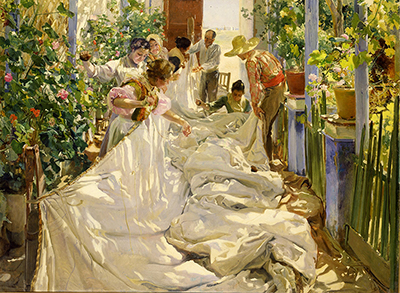Also known as Mending Sails, Sewing the Sails is one of the best works by unsung Spanish hero Joaquin Sorolla. Sorolla was dubbed "the master of light" by the likes of John Singer Sargent and Claude Monet. Sorolla's Sewing the Sails painting was created in 1896 on a 222 cm by 300 cm canvas.
It is an oil painting featuring a variety of art styles, including luminism, impressionism, and realism. Like most of Joaquin Sorolla's pieces, this painting is quite a colorful piece. It depicts a group of people (5 women and two men) who are repairing a boat's sail. At the far end in the background of the painting is a man probably in his late forties. The man appears to have a half-bald head, and he wears a white shirt and grey pants. Behind him is an image of the backrest of a chair, and the older man obscures the rest of the chair. A door is also painted behind the man. The man holds part of the sail. Next to the man is a lady with black hair. The face of the lady is not displayed as she appears to be facing the older man and holding on to the sail. Both her hands are holding the white sail, and the sail obscures the rest of her body.
Next to the lady is another woman who has her hair covered with a beige wrap. Apart from her face, most of her features are obscured by the other people in front of her. The second woman faces a third one who is also a black-haired lady with white garments. Opposite the second lady is the third one who is sitting on the floor. One of her hands is lifted in a manner that depicts that she is moving the needle and thread while sewing. Next to her is a man with a straw hat, a colorful shirt, and brown pants who is holding the sail with one hand. Finally, the foreground is another lady with brown hair.
Most of the foreground of the painting is the white boat sail, which is spread between the people and extends far past the last lady. The sail appears to be lying on top of a brown fabric that is displayed on its sides. The people are in a floral courtyard with flowerpots, plants, and railing surrounding them. Sunlight can be seen coming through the railings and the plants onto the sail material and the people sewing. The most dominant color in this painting is white, which is worn by most of the people depicted and the boat’s sail. There are also other colors like yellow, green, grey, red, blue, orange, pink, and brown, among others.
Sorolla started his career as more of an artist depicting severe social issues. Most of his work at the time featured the theme of social consciousness. He, therefore, drew his inspiration from the society and the experiences of other people as well as his. However, a few years down the line, Sorolla began moving towards lighter subjects with paintings of images like the beach. At this point, he drew most of his inspiration from his family. Some of his most famous works, like women on the beach, feature his wife and daughter. He has also featured his son in a couple of his paintings before his passing. Like most of his work, the location of this Joaquin Sorolla piece is Valencia, Spain. Sorolla painted realistic images that he saw and experienced in his day to day life. Valencia was his hometown and the location of most of his compositions.




